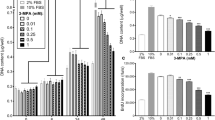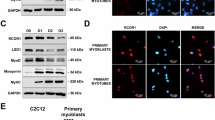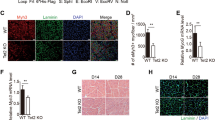Abstract
Myogenic differentiation requires the coordination between permanent cell cycle withdrawal, mediated by members of the cyclin-dependent kinase inhibitor (CKI) family, and activation of a cascade of myogenic transcription factors, particularly MYOGENIN (MYOG). Recently, it has been reported that the Protein aRginine Methyl Transferase PRMT5 modulates the early phase of induction of MYOG expression. Here, we show that the histone- and PRMT5-associated protein COPR5 (cooperator of PRMT5) is required for myogenic differentiation. C2C12 cells, in which COPR5 had been silenced, could not irreversibly exit the cell cycle and differentiate into muscle cells. This phenotype might be explained by the finding that, in cells in which COPR5 was downregulated, p21 and MYOG induction was strongly reduced and PRMT5 recruitment to the promoters of these genes was also altered. Moreover, we suggest that COPR5 interaction with the Runt-related transcription factor 1 (RUNX1)–core binding factor-β (CBFβ) complex contributes to targeting the COPR5–PRMT5 complex to these promoters. Finally, we present evidence that COPR5 depletion delayed the in vivo regeneration of cardiotoxin-injured mouse skeletal muscles. Altogether, these data extend the role of COPR5 from an adaptor protein required for nuclear functions of PRMT5 to an essential coordinator of myogenic differentiation.
Similar content being viewed by others
Log in or create a free account to read this content
Gain free access to this article, as well as selected content from this journal and more on nature.com
or
Abbreviations
- CKI:
-
cyclin-dependent kinase inhibitor
- MYOG :
-
MYOGENIN
- PRMT5 :
-
protein arginine methyl transferase 5
- COPR5 :
-
cooperator of PRMT5
- RUNX1 :
-
Runt-related transcription factor 1
- CBFβ:
-
core binding factor-β
References
Sherr CJ, Roberts JM . Inhibitors of mammalian G1 cyclin-dependent kinases. Genes Dev 1995; 9: 1149–1163.
Sang L, Coller HA, Roberts JM . Control of the reversibility of cellular quiescence by the transcriptional repressor HES1. Science 2008; 321: 1095–1100.
Halevy O, Novitch BG, Spicer DB, Skapek SX, Rhee J, Hannon GJ et al. Correlation of terminal cell cycle arrest of skeletal muscle with induction of p21 by MyoD. Science 1995; 267: 1018–1021.
Guo K, Wang J, Andres V, Smith RC, Walsh K . MyoD-induced expression of p21 inhibits cyclin-dependent kinase activity upon myocyte terminal differentiation. Mol Cell Biol 1995; 15: 3823–3829.
Andres V, Walsh K . Myogenin expression, cell cycle withdrawal, and phenotypic differentiation are temporally separable events that precede cell fusion upon myogenesis. J Cell Biol 1996; 132: 657–666.
Zhang P, Wong C, Liu D, Finegold M, Harper JW, Elledge SJ . p21(CIP1) and p57(KIP2) control muscle differentiation at the myogenin step. Genes Dev 1999; 13: 213–224.
Puri PL, Avantaggiati ML, Balsano C, Sang N, Graessmann A, Giordano A et al. p300 is required for MyoD-dependent cell cycle arrest and muscle-specific gene transcription. EMBO J 1997; 16: 369–383.
Bedford MT, Richard S . Arginine methylation an emerging regulator of protein function. Mol Cell 2005; 18: 263–272.
Litt M, Qiu Y, Huang S . Histone arginine methylations: their roles in chromatin dynamics and transcriptional regulation. Biosci Rep 2009; 29: 131–141.
Scoumanne A, Zhang J, Chen X . PRMT5 is required for cell-cycle progression and p53 tumor suppressor function. Nucleic Acids Res 2009; 37: 4965–4976.
Pal S, Vishwanath SN, Erdjument-Bromage H, Tempst P, Sif S . Human SWI/SNF-associated PRMT5 methylates histone H3 arginine 8 and negatively regulates expression of ST7 and NM23 tumor suppressor genes. Mol Cell Biol 2004; 24: 9630–9645.
Tee WW, Pardo M, Theunissen TW, Yu L, Choudhary JS, Hajkova P et al. Prmt5 is essential for early mouse development and acts in the cytoplasm to maintain ES cell pluripotency. Genes Dev 2011; 24: 2772–2777.
Fabbrizio E, El Messaoudi S, Polanowska J, Paul C, Cook JR, Lee JH et al. Negative regulation of transcription by the type II arginine methyltransferase PRMT5. EMBO Rep 2002; 3: 641–645.
Kwak YT, Guo J, Prajapati S, Park KJ, Surabhi RM, Miller B et al. Methylation of SPT5 regulates its interaction with RNA polymerase II and transcriptional elongation properties. Mol Cell 2003; 11: 1055–1066.
Pal S, Yun R, Datta A, Lacomis L, Erdjument-Bromage H, Kumar J et al. mSin3A/histone deacetylase 2- and PRMT5-containing Brg1 complex is involved in transcriptional repression of the Myc target gene cad. Mol Cell Biol 2003; 23: 7475–7487.
Hou Z, Peng H, Ayyanathan K, Yan KP, Langer EM, Longmore GD et al. The LIM protein AJUBA recruits protein arginine methyltransferase 5 to mediate SNAIL-dependent transcriptional repression. Mol Cell Biol 2008; 28: 3198–3207.
Ancelin K, Lange UC, Hajkova P, Schneider R, Bannister AJ, Kouzarides T et al. Blimp1 associates with Prmt5 and directs histone arginine methylation in mouse germ cells. Nat Cell Biol 2006; 8: 623–630.
Dacwag CS, Ohkawa Y, Pal S, Sif S, Imbalzano AN . The protein arginine methyltransferase Prmt5 is required for myogenesis because it facilitates ATP-dependent chromatin remodeling. Mol Cell Biol 2007; 27: 384–394.
Lacroix M, Messaoudi SE, Rodier G, Le Cam A, Sardet C, Fabbrizio E . The histone-binding protein COPR5 is required for nuclear functions of the protein arginine methyltransferase PRMT5. EMBO Rep 2008; 9: 452–458.
Blau HM, Pavlath GK, Hardeman EC, Chiu CP, Silberstein L, Webster SG et al. Plasticity of the differentiated state. Science 1985; 230: 758–766.
Clegg CH, Linkhart TA, Olwin BB, Hauschka SD . Growth factor control of skeletal muscle differentiation: commitment to terminal differentiation occurs in G1 phase and is repressed by fibroblast growth factor. J Cell Biol 1987; 105: 949–956.
Dacwag CS, Bedford MT, Sif S, Imbalzano AN . Distinct protein arginine methyltransferases promote ATP-dependent chromatin remodeling function at different stages of skeletal muscle differentiation. Mol Cell Biol 2009; 29: 1909–1921.
Sambasivan R, Cheedipudi S, Pasupuleti N, Saleh A, Pavlath GK, Dhawan J . The small chromatin-binding protein p8 coordinates the association of anti-proliferative and pro-myogenic proteins at the myogenin promoter. J Cell Sci 2009; 122: 3481–3491.
Kobayashi T, Kageyama R . Hes1 regulates embryonic stem cell differentiation by suppressing Notch signaling. Genes Cells 2009; 15: 689–698.
Cossins J, Vernon AE, Zhang Y, Philpott A, Jones PH . Hes6 regulates myogenic differentiation. Development 2002; 129: 2195–2207.
Philipot O, Joliot V, Ait-Mohamed O, Pellentz C, Robin P, Fritsch L et al. The core binding factor CBF negatively regulates skeletal muscle terminal differentiation. PLoS One 2010; 5: e9425.
Ieronimakis N, Balasundaram G, Rainey S, Srirangam K, Yablonka-Reuveni Z, Reyes M . Absence of CD34 on murine skeletal muscle satellite cells marks a reversible state of activation during acute injury. PLoS One 2010; 5: e10920.
Myers TK, Andreuzza SE, Franklin DS . p18INK4c and p27KIP1 are required for cell cycle arrest of differentiated myotubes. Exp Cell Res 2004; 300: 365–378.
Figliola R, Maione R . MyoD induces the expression of p57Kip2 in cells lacking p21Cip1/Waf1: overlapping and distinct functions of the two cdk inhibitors. J Cell Physiol 2004; 200: 468–475.
Roy K, de la Serna IL, Imbalzano AN . The myogenic basic helix-loop-helix family of transcription factors shows similar requirements for SWI/SNF chromatin remodeling enzymes during muscle differentiation in culture. J Biol Chem 2002; 277: 33818–33824.
Zhao X, Jankovic V, Gural A, Huang G, Pardanani A, Menendez S et al. Methylation of RUNX1 by PRMT1 abrogates SIN3A binding and potentiates its transcriptional activity. Genes Dev 2008; 22: 640–653.
Bartfeld D, Shimon L, Couture GC, Rabinovich D, Frolow F, Levanon D et al. DNA recognition by the RUNX1 transcription factor is mediated by an allosteric transition in the RUNT domain and by DNA bending. Structure 2002; 10: 1395–1407.
Hawke TJ, Meeson AP, Jiang N, Graham S, Hutcheson K, DiMaio JM et al. p21 is essential for normal myogenic progenitor cell function in regenerating skeletal muscle. Am J Physiol Cell Physiol 2003; 285: C1019–C1027.
Butler JS, Zurita-Lopez CI, Clarke SG, Bedford MT, Dent SY . Protein arginine methyltransferase 1 (PRMT1) methylates Ash2L, A shared component of mammalian histone H3K4 methyltransferase complexes. J Biol Chem 2011; 286: 12234–12244.
McKinnell IW, Ishibashi J, Le Grand F, Punch VG, Addicks GC, Greenblatt JF et al. Pax7 activates myogenic genes by recruitment of a histone methyltransferase complex. Nat Cell Biol 2008; 10: 77–84.
Kim JM, Sohn HY, Yoon SY, Oh JH, Yang JO, Kim JH et al. Identification of gastric cancer-related genes using a cDNA microarray containing novel expressed sequence tags expressed in gastric cancer cells. Clin Cancer Res 2005; 11: 473–482.
Pal S, Baiocchi RA, Byrd JC, Grever MR, Jacob ST, Sif S . Low levels of miR-92b/96 induce PRMT5 translation and H3R8/H4R3 methylation in mantle cell lymphoma. EMBO J 2007; 26: 3558–3569.
El Messaoudi S, Fabbrizio E, Rodriguez C, Chuchana P, Fauquier L, Cheng D et al. Coactivator-associated arginine methyltransferase 1 (CARM1) is a positive regulator of the Cyclin E1 gene. Proc Natl Acad Sci USA 2006; 103: 13351–13356.
Schertzer JD, Gehrig SM, Ryall JG, Lynch GS . Modulation of insulin-like growth factor (IGF)-I and IGF-binding protein interactions enhances skeletal muscle regeneration and ameliorates the dystrophic pathology in mdx mice. Am J Pathol 2007; 171: 1180–1188.
Acknowledgements
We thank G Carnac for primary human skeletal muscle myoblasts; S Ait-Sit-Ali for RUNX1 constructs; our animal facility staff, the RHEM facility (Réseau d’Histologie Expérimentale de Montpellier) and all members of the CS laboratory for helpful discussions. This work was realized with institutional supports of the French CNRS and grants from the FRM, ANR (CS,équipe labélisée 2007) and ARC (EF).
Author information
Authors and Affiliations
Corresponding authors
Ethics declarations
Competing interests
The authors declare no conflict of interest.
Additional information
Edited by R De Maria
Supplementary Information accompanies the paper on Cell Death and Differentiation website
Rights and permissions
About this article
Cite this article
Paul, C., Sardet, C. & Fabbrizio, E. The histone- and PRMT5-associated protein COPR5 is required for myogenic differentiation. Cell Death Differ 19, 900–908 (2012). https://doi.org/10.1038/cdd.2011.193
Received:
Revised:
Accepted:
Published:
Issue date:
DOI: https://doi.org/10.1038/cdd.2011.193
Keywords
This article is cited by
-
NF1 microdeletion syndrome: case report of two new patients
Italian Journal of Pediatrics (2019)
-
Emerging genotype–phenotype relationships in patients with large NF1 deletions
Human Genetics (2017)
-
The PRMT5 arginine methyltransferase: many roles in development, cancer and beyond
Cellular and Molecular Life Sciences (2015)
-
miR-24 affects hair follicle morphogenesis targeting Tcf-3
Cell Death & Disease (2013)



